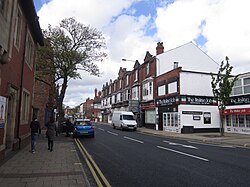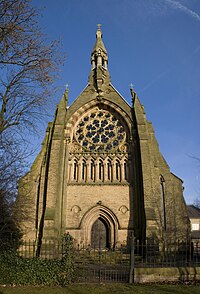Difference between revisions of "Urmston"
(Created page with "{{Infobox town |name=Urmston |county=Lancashire |picture=Station Road, Urmston.JPG |picture caption=Station Road, Urmston |os grid ref=SJ766947 |latitude=53.4487 |longitude=-2...") |
m (→Churches: ioe -> nhle, replaced: {{IoE|212985 → {{NHLE|1067876, {{IoE|212996 → {{NHLE|1067879, {{IoE|212986 → {{NHLE|1162835, {{IoE|212994 → {{NHLE|1162878, {{IoE|212987 → {{NHLE|1356521) |
||
| Line 51: | Line 51: | ||
*Church of England: | *Church of England: | ||
| − | **St Clement<ref>{{ | + | **St Clement<ref>{{NHLE|1162878|Church of St Clement}}</ref> |
| − | **St Michael's<ref>{{ | + | **St Michael's<ref>{{NHLE|1067876|Church of St Michael</ref> |
*Baptist & Congregational: Greenfield Church | *Baptist & Congregational: Greenfield Church | ||
*Methodist: | *Methodist: | ||
| Line 59: | Line 59: | ||
**Urmston Methodist Church | **Urmston Methodist Church | ||
*Roman Catholic: | *Roman Catholic: | ||
| − | **All Saints<ref>{{ | + | **All Saints<ref>{{NHLE|1067879|Church of All Saints}}</ref> |
**Our Lady & The English Martyrs | **Our Lady & The English Martyrs | ||
| − | The Church of St Michael was first mentioned in 1189–91 although may be even older. It was rebuilt in 1815, 1824, and 1888.<ref>Nevell (1997), p. 29, 106.</ref> There are two listed structures in the grounds of the church, the sundial and the Jones Chest tomb.<ref>{{ | + | The Church of St Michael was first mentioned in 1189–91 although may be even older. It was rebuilt in 1815, 1824, and 1888.<ref>Nevell (1997), p. 29, 106.</ref> There are two listed structures in the grounds of the church, the sundial and the Jones Chest tomb.<ref>{{NHLE|1356521|Sundial at Church of St Michael}}</ref><ref>{{NHLE|1162835|Tomb at Church of St Michael}}</ref> |
St Clement's was built in 1868 by J Medland Taylor, in the Gothic Revival style. | St Clement's was built in 1868 by J Medland Taylor, in the Gothic Revival style. | ||
Latest revision as of 10:58, 19 September 2019
| Urmston | |
| Lancashire | |
|---|---|
 Station Road, Urmston | |
| Location | |
| Grid reference: | SJ766947 |
| Location: | 53°26’55"N, 2°22’29"W |
| Data | |
| Population: | 41,825 (2011) |
| Post town: | Manchester |
| Postcode: | M41 |
| Dialling code: | 0161 |
| Local Government | |
| Council: | Trafford |
| Parliamentary constituency: |
Stretford and Urmston |
Urmston is a town in Lancashire, with a population of 41,825 at the 2011 Census, about six miles south-west of Manchester city centre. The southern boundary is the River Mersey, with Stretford lying to the east and Flixton to the west. Davyhulme lies to the north of the town centre.
The town has early mediæval origins, and until the arrival of the railway in 1873 was a small farming community. The railway acted as a catalyst, transforming the town into a residence for the middle classes. Today, Urmston is a substantial town in a wider conurbation.
History
Fragments of Roman pottery were found in 1983, in the area now occupied by the cemetery – previously the site of Urmston Old Hall – suggesting that there may have been a Roman settlement on the site.[1] In the early 13th century, Lord Greenhalgh and his family lived at Highfield House (under what is now the M60 motorway).
William the Conqueror gave his kinsman Roger de Poictou all of the land between the River Mersey and the River Ribble. Part of this land was in turn given to Albert de Greslet, who towards the end of the 12th century, bestowed as much land as a team of oxen could plough in one-year on Orme Fitz Seward, the son of Edward Aylward.[2] It is probable that the name Urmston is derived from Orme's Easton, or Ormestun, the "tun" or dwelling of Orme Fitz Seward.
The Manor of Urmston was rented by a family using the local surname. The earliest known member of the Urmston family is Richard de Urmston, who was recorded in 1193–94 as giving 40 shillings "for having the king's good will".[3] Orme Fitz Seward's land passed to Richard de Trafford in the 13th century. The de Trafford family later lost the land, but won it back as the result of a duel.
Urmston Old Hall was the home of the manorial lord, and a centre of power in the area during the Middle Ages. The Old Hall was completely rebuilt in brick and timber in the late 16th century. New Croft Hall, also in Urmston, was the residence of a wealthy freeman and may have been moated. Urmston was only one of three manors in Trafford to have had two mediæval halls, the others being Hale and Timperley. Neither of the halls has survived to the present day.[4]
Farming was the main occupation in Urmston until the early 19th century, when weaving became a significant source of employment, although this later declined due to competition from large industry. In 1848, the population was recorded as being 771, with around 80% of the land being farmed.[5] The opening of the Cheshire Lines Railway in 1873 allowed the town to grow as a commuter town: between 1871 and 1901 the population grew by over 650%, from 996 to 6,594. By 1901, farming had virtually died out, and the town became a residence for the middle classes.[6]
Society
- Music and drama:
- Urmston Musical Theatre was formed as the Urmston and District Operatic Society in 1911. It performs an adult main show in October and a pantomime in January/February, at the Poolside Theatre. Its youth section performs a show in May.[7]
- Canterbury Players, a local amateur dramatic society.
The Beatles
In 1963 the council booked the Beatles to play at the Urmston Show at Abbotsfield Park in Chassen Road on Monday 5 August. At the time of the booking, they were not well known, but had risen in popularity by the time of their appearance.[8] David Hamilton who was the compere, commented: "The boys were smuggled in in a van ... screaming girls rushed the stage, trying to get hold of their idols ... it was certainly a hard day's night."
Sport
- Cricket:
- Urmston Cricket Club, founded in 1846
- Urmston & Flixton Cricket Club, which encompasses sports including hockey, tennis, and bowls.[9]
- Football: AFC Urmston, founded in 1977 as Meadowside Athletic FC
- Riding: Urmston Riding Club, established in 1956
Churches
Churches in the town include:
- Church of England:
- Baptist & Congregational: Greenfield Church
- Methodist:
- Brook Road Methodist Church
- Cornerstone Church
- Urmston Methodist Church
- Roman Catholic:
- All Saints[12]
- Our Lady & The English Martyrs
The Church of St Michael was first mentioned in 1189–91 although may be even older. It was rebuilt in 1815, 1824, and 1888.[13] There are two listed structures in the grounds of the church, the sundial and the Jones Chest tomb.[14][15]
St Clement's was built in 1868 by J Medland Taylor, in the Gothic Revival style.
Outside links
| ("Wikimedia Commons" has material about Urmston) |
References
- ↑ Nevell (1997), p. 17, 20.
- ↑ Urmston.Net, The Urmston Partnership, http://www.urmston.net/local_history.asp, retrieved 20 April 2007
- ↑ Townships: Urmston
- ↑ Nevell (1997), p. 49, 74.
- ↑ 'Urchfont – Uxbridge', A Topographical Dictionary of England (1848), pp. 424–28, British History Online, http://www.british-history.ac.uk/report.asp?compid=51365, retrieved 26 April 2007
- ↑ Nevell (1997), p. 62, 86–87, 100.
- ↑ The Urmston Musical Theatre
- ↑ Harry (2000), pp. 5–6.
- ↑ [http://www.urmstonchbts.org.uk Urmston Cricket, Hockey, Bowls, Tennis & Social Club
- ↑ National Heritage List 1162878: Church of St Clement
- ↑ {{NHLE|1067876|Church of St Michael
- ↑ National Heritage List 1067879: Church of All Saints
- ↑ Nevell (1997), p. 29, 106.
- ↑ National Heritage List 1356521: Sundial at Church of St Michael
- ↑ National Heritage List 1162835: Tomb at Church of St Michael
- Harry, Bill (2000), The Beatles Encyclopaedia (2000 paperback edition; first published 1992), London: Virgin Publishing, pp. 5–6, ISBN 0-7535-0481-2
- Nevell, Mike (1997), The Archaeology of Trafford, Trafford Metropolitan Borough with University of Manchester Archaeological Unit, ISBN 1-870695-25-9
- Rendell, Douglas (1998), Cinemas of Trafford, Jarvis Print Group Limited, ISBN 0-9512560-1-7

